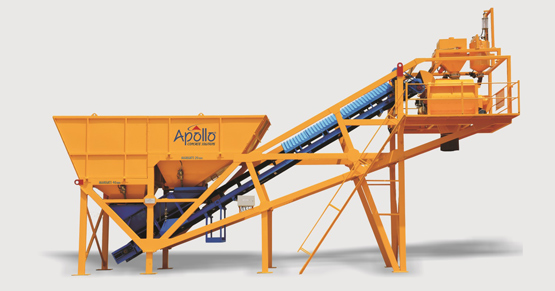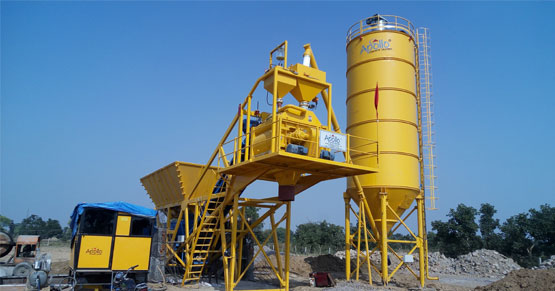The concrete industry is experiencing a wave of innovation as advancements in concrete batching plant technology reshape the way concrete is produced, transported, and utilized. These developments are driven by the demand for sustainable construction practices, higher efficiency, and precision. For concrete batching plant manufacturers in India and across the globe, staying ahead of these trends is critical to meeting the evolving needs of the construction sector. This article explores the latest trends in concrete batching plant technology as we step into 2025, focusing on capacity, design, and technological advancements.
Importance of Concrete Batching Plants
Concrete batching plants are integral to modern construction projects, producing ready-mix concrete with consistent quality and precision. These plants mix various ingredients—cement, water, sand, and aggregates—into a homogenous blend that can be transported and used on-site.
Key Functions of Concrete Batching Plants
- Precise measurement of materials.
- Consistent mixing for uniform quality.
- Scalability to meet project-specific requirements.

Trends in Concrete Batching Plant Technology
1. Automation and Digitalization
Automation has become a cornerstone of modern concrete batching plants, improving efficiency and reducing human intervention.
- Real-Time Monitoring: IoT-enabled plants provide real-time updates on material usage, production rates, and machine performance.
- User-Friendly Interfaces: Advanced control systems with intuitive dashboards make operations more accessible.
2. Modular and Compact Designs
The need for flexibility has given rise to modular and compact batching plant designs.
- Ease of Transportation: Modular plants can be disassembled and moved to different sites quickly.
- Space Efficiency: Compact designs are ideal for urban areas where space is limited.
3. Increased Concrete Batching Plant Capacity
As projects scale up, there is a growing demand for high-capacity batching plants.
- Customizable Output: Manufacturers now offer plants with adjustable capacities to meet specific project requirements.
- High-Speed Production: Advanced technology ensures faster mixing and delivery without compromising quality.
4. Sustainable and Green
Sustainability is at the forefront of innovation in concrete batching plant design.
- Eco-Friendly Mix Designs: Support for low-carbon concrete and alternative materials like fly ash and slag.
5. Mobile Concrete Batching Plants
Mobile plants have gained popularity due to their convenience and versatility.
- On-Site Production: Ideal for remote locations or time-sensitive projects.
- Quick Setup: Designed for rapid installation and operation.
6. Advanced Mixing Technologies
New mixing technologies ensure better consistency and quality in concrete production.
- Twin-Shaft Mixers: Provide high-speed and uniform mixing, even for dense or complex mixes.
- High-Efficiency Blades: Minimize mixing time and energy consumption.
7. Data-Driven Decision Making
The integration of big data analytics helps plant operators make informed decisions.
- Material Optimization: Analyze ingredient usage to reduce waste.
- Performance Tracking: Monitor plant efficiency and address bottlenecks.
Concrete Batching Plant Demand in India
India’s infrastructure boom has spurred the demand for concrete batching plants, especially in urban and semi-urban areas.
Metropolitan Areas:
Cities like Delhi, Mumbai, and Bangalore require high-capacity plants to support large-scale metro rail, highway, and residential projects.
Rural and Semi-Rural Areas:
In regions focusing on irrigation, rural housing, and road connectivity, mobile and compact plants are preferred for their versatility.

Role of Indian Manufacturers in Shaping the Industry
1. Competitive Pricing
Indian manufacturers offer cost-effective solutions without compromising quality, making them a preferred choice in price-sensitive markets.
2. Customization
From small-scale mobile plants to large-capacity systems, manufacturers design plants tailored to specific requirements.
3. Technological Advancements
By adopting global best practices and integrating local expertise, Indian manufacturers are at the forefront of innovation.
4. Export Potential
Indian-made plants are gaining traction in Africa, the Middle East, and Southeast Asia due to their affordability and reliability.
Benefits of Modern Concrete Batching Plants
1. Improved Quality Control
Advanced systems ensure precise measurement of materials, resulting in consistent quality.
2. Enhanced Productivity
High-capacity plants and efficient designs minimize downtime and maximize output.
3. Environmental Compliance
Energy-efficient and waste-reduction technologies help meet sustainability goals.
4. Cost Savings
Automation and real-time monitoring reduce operational costs by optimizing resource usage.
Challenges in Adopting New Technologies
Despite the advantages, several challenges remain:
- High Initial Costs: Advanced plants require significant investment, which may deter small contractors.
- Skilled Workforce: Operating modern plants requires trained personnel, which is a challenge in certain regions.
- Infrastructure Constraints: Transporting large plants to remote locations can be logistically complex.
Opportunities for Growth
- Government Initiatives: Programs like Smart Cities Mission and Pradhan Mantri Awas Yojana are driving infrastructure development, boosting demand for batching plants.
- Focus on Sustainability: The shift towards green construction practices presents opportunities for manufacturers to innovate eco-friendly solutions.
- Expanding Export Markets: Indian manufacturers can capitalize on the growing demand for cost-effective batching plants in developing countries.
Conclusion
The evolution of concrete batching plant technology in 2025 reflects the construction industry’s commitment to efficiency, sustainability, and innovation. From automation and modular designs to energy-efficient solutions, the latest trends are reshaping how concrete is produced and used in infrastructure projects. For concrete batching plant manufacturers in India, embracing these trends is essential to remain competitive and meet the diverse needs of modern construction.
By investing in advanced systems and sustainable practices, the industry can drive growth while contributing to a greener future. Whether in metropolitan cities or rural areas, the demand for efficient and versatile batching plants is set to rise, making this an exciting time for innovation and expansion in the sector.
- Economic Series Concrete Batching Plants for Infrastructure Projects in Rural India
- Concrete Block Making Machines: Essential for Affordable Housing Projects
- How Tier-2 and Tier-3 Indian Cities Are Driving Demand for Concrete Pipe Machines?
- The Role of Concrete Pipe Making Machines in Smart Cities Development in India
- The Role of Concrete Block Making Machines in Affordable Housing Development in India


